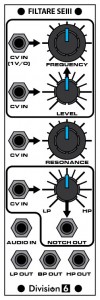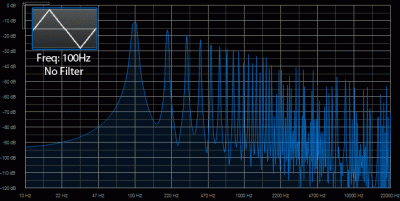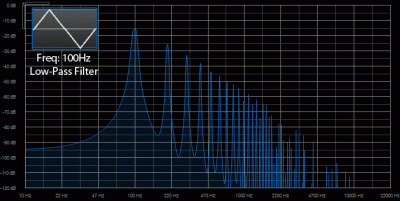
There are a few common ways to generate the sounds that get manipulated, modified, and are eventually sent out of your synthesizer. In this lesson we’re going to talk about subtractive synthesis. This is the type of synthesis primarily used by old-school analog synths.
The basic idea of subtractive synthesis is to start with a waveform that is being generated by an oscillator, then remove certain frequencies with a filter until you get the desired sound.
Why would removing different frequencies alter the sound? After all, the waveform coming from the oscillator is just a single frequency, right? The filter would either just let the sound through or it wouldn’t.
That’s why it was important to understand harmonics before we got here. The filter selectively removes certain harmonics, altering the spectral content of the waveform. A filter wouldn’t do much to alter the sound of a sine wave (since it contains no harmonics), but for harmonic-rich waves like square, triangle and sawtooth, it makes quite a bit of difference.
One of the main controls on a filter is “cutoff frequency”, which sets the point where the filter starts blocking frequencies. There are several different types of filters which may block frequencies lower, higher, or right at the cutoff frequency:
Low-Pass: Removes frequencies above the cutoff frequency. Makes waves sound darker or muddier.
High-Pass: Removes frequencies below the cutoff frequency. Makes waves sound brighter.
Band-Pass: Lets a narrow band of frequencies centered around the cutoff frequency through.
Notch / Band-Reject: Removes a narrow band of frequencies centered around the cutoff frequency.
In the two images below, note how running a triangle wave through a low-pass filter reduces the upper harmonics.
Another control found on many filters is “resonance”. Turning this up gives the harmonics right at the cutoff frequency a boost.
Don’t worry, we’ll look at filters in more detail in later lessons.
There you have subtractive synthesis in a nutshell; start with a wave, carve away everything that you don’t want in it, and you have your sound.















Don’t forget about PD, or Phase Distortion synthesis! Maybe this is just another FM type synthesis?
http://en.wikipedia.org/wiki/Phase_distortion_synthesis